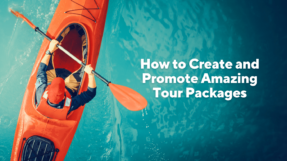
| N.B. This is a guest post by Andrea Appin, the lead marketer at TourismTiger, a web design company dedicated to building beautiful and affordable websites for tourism and activity operators. |  |
As the last of the tourists leave in dribs and drabs, most tour operators are left with the reality that off season is about to come into full swing.
While it’s undeniably not the best time of the year for selling tours, it can prove to be beneficial in other regards: the dwindling amount of tourists running around will free up some of your precious time to start focusing on a game plan to make the most out of high season.
So the question is — what should you focus on? Well, according to a recent study 148.3 million travel related bookings are made online each year — which is a whopping 57% of all travel bookings. With that in mind, you really need to amp up your online presence to take advantage of all of those tourists spending their dollar bills all over the Internet.
Our advice? Do some spring cleaning on your website and develop a strong online presence.
Just follow our five simple steps to get your site ready to put its best digital foot forward.
#1 Monitor your speed
Before I get down to any of the nitty gritty details, I’m going to smack you with another cold hard fact. Ready for it? Three seconds. Three seconds is the maximum amount of time most internet users will wait for any single webpage to load.
So regardless of how nice your website is, people aren’t going to hang around to marvel at its beauty if it loads at snail’s pace.
And the thing is, this is a disaster that can be easily avoided with a very simple and easy to use tool by Google.This ingenious tool aptly named Google PageSpeed Insights will tell give you a score letting you know exactly how fast (or slow) your page is. Just go to their site, enter your URL and in seconds it will reveal a number from 0-100 — and just like in school, the higher you get, the better you did.
Wanna know what’s even better? They give you a breakdown of exactly what you need to do to increase your score. Pretty cool, huh?
Pro-tip: Large image files are notorious for slowing down pages. And spending the time to manually optimize them can be a pain.
If you want to make your life ultra easy, skip the hassle of optimizing them manually. Instead, after you’ve received your Google PageSpeed Insights score, scroll down to the bottom of the page and you’ll find a wonderful gift from Google to you — a link to all of your images, automatically optimized for you by Google (as shown below):
#2 Create meaningful content
This one should be obvious — people are on your site for two reasons 1.) they want to know more about your tours and 2.) they want to know more about your tourism company.
So, let’s start with your tours.
First things first, you should make it ultra easy for anyone viewing your page to find information for the exact kind of tour they are looking for.
Your best best? Display your tour options smack dab on your homepage — and be sure to include titles, short descriptions and images.
TumaloCreek did this and their tours are seriously impossible to miss.
So when potential customers find tour options that strike their fancy from the initial menu, whatever they read after they click on the tour image will probably be a deal breaker when it comes to going ahead with the purchase.
You need to ‘wow’ them with a great tour description — and you need to include all the key details that they might be interested in.
TumaloCreek made sure to include every relevant detail about their tour to ensure that anyone considering signing up knows exactly what they’re in for.
Want to write even better tour descriptions? We’ve created a very specific method to make sure that you write the perfect tour description every time. Check it out here.
Now that you have the meat of your website, you need to add some credibility to your website by creating a great about page (because if people are going to book their tours through you, they want to know that they are booking with a reliable — and awesome — tour operator).
There’s no magic formula to crafting a perfect about page, but keep it short and make sure that your personality shines through. Also include any industry-relevant and noteworthy awards you have received or tourism associations you are part of. This will make your story seem that much more credible.
#3 Include impactful imagery
Most successful tourism websites have at least one thing in common: they all include images that elicit the “wow, I want to go there and do that” response.
So the obvious takeaway from this would be to include pictures on your site, because the old adage of a picture being worth than a thousand words is true after all.
Sadly though, it is true in more ways than one: a picture can win a customer over completely or it can make them frown and turn to your competition for tour options.
Just look at the pictures below:
These pictures are taken of the exact same beach. The picture on the left was taken on a gloomy cold day; conversely, the picture on the right was taken on a picture-perfect sunny day that shows off the clarity of the ocean and the white sandy beach.
My guess is that you, and almost everyone else, would prefer going to that beach on that picture-perfect day. Well, the same rule applies for the pictures that you show-off on your site.
When looking at photos of tours, people envision themselves in a similar situation while on your tours. And of course, you want the picture to evoke the best possible emotions. So make sure that you get professional photos taken on a sunny day.
A word of warning: if you run your tours in a naturally wet or rainy location, don’t display pictures that represent the one sunny day of the year. This will set an impossible benchmark that could lead to some wet and upset customers.
Pro-tip: If you can’t get a hold of a professional photographer, go to a local university and find a photography student who wants to build up their portfolio — they’ll be eager to cut you a major deal.
#4 Back it up with social proof
Earlier in this post I spoke about including accolades and awards on your website to reaffirm that you are a credible and trustworthy tour operator; there are, however, many other ways to convey this message to viewers. This is where social proof comes into play.
So what exactly is social proof? Well, it’s the reason we get hooked on the latest trends. It’s the reason why we spend an outrageous amount on new shoes or a designer and bag — we do it largely because everyone else is doing it. And because everyone else is doing it, it must be good.
While this isn’t always the soundest of logic for rationalizing major life-impacting choices, it definitely is a great tool to leverage when selling your tours.
The idea is simple — you want everybody to know that other real-life people think that your tours are the best out there.
How do you do that? Well, you could get some testimonials, copy and paste them on your site and hope that people believe that they’re real. And often times, even this simple tactic does actually work.
The thing is though, people are becoming more and more paranoid in this day and age — especially with how quickly and easily it is to fact check things. And some of those paranoid folks might just question the authenticity of the testimonials.
More than likely, they’d probably jet over to places like TripAdvisor and Yelp to peruse over some more testimonials.
To save them all that trouble though, try integrating a TripAdvisor widget by your tour descriptions. They are free of charge and display real-time information
#5 Know your weaknesses
Congratulations! You now have the basic nuts and bolts for a successful, user-friendly website that will help you increase your sales.
But don’t get too excited just yet. Even though you have a great overall framework for your website, it doesn’t mean that it is completely error proof — almost every website has some weaknesses here and there. So instead of assuming greatness from the get go, make sure that you test everything out.
You can either get elements on your site A/B tested — which is a great idea, but it requires a lot of monthly unique visitors. Or you can use HotJar which has no minimum user requirement — and it is completely free!
They provide heat-maps and screen recording sessions which show you areas of interest and confusion on your website — invaluable information that could seriously impact your sales.
Show your website off
If you follow these tips, you should come out with a super strong website — but the only way it will start turning into a sales-making machine is if you start showing it off in as many channels as possible.
One last piece of advice: sign up to as many OTAs, directories, marketplaces and review sites as you can. And maybe — just maybe, the off season will soon become a fleeting thought of the past.









